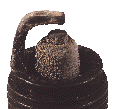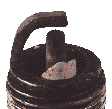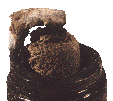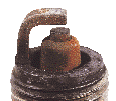| The ability to read spark plugs can tell a mechanic a lot
about the state of tune of an engine and about some of the problems an engine may be
experiencing. In the absence of other more sophisticated equipment, the simple act of
removing the spark plugs and examining them under a low power magnifying glass can help
jet the carburetor, set ignition advance, recognize additives in fuel and many other
conditions. While no one can learn to read spark plugs by simply studying a short article
like this, you can learn the basics. What Does a Spark Plug Really Do?
Do I Need To Use a Resistor?
How Does Heat Range Affect a Plug?
Installation Tips
Reading the Plugs
Normal Firing End
Worn Out
Detonation
Mechanical Damage
Overheated
Ash Deposits
Oil Fouled
Initial Pre-Ignition
Sustained Pre-ignition
Splash Deposits
Carbon Fouled
Fuel Additives
| What Does A Spark Plug Really Do? |
The
definition of the spark plug's purpose is straight forward. A spark plug seals the
combustion chamber. It conducts a spark that is generated in the ignition coil into the
combustion chamber and provides a gap for that spark to jump across. Finally, it conducts
the heat it picks up in the combustion process to the cylinder head and into the cooling
system. When a spark plug provides these three basic items, it is then capable of
initiating the combustion process, There is a large amount of technology which goes into
the design and manufacture of a spark plug that meets these requirements and provides long
life and superior engine performance. It is important to remember that there is no design
that will allow a spark plug to generate more voltage or hotter spark because the spark
energy is generated in the coil. It is also important to remember that spark plugs do not
produce heat. They pick up heat from the combustion chamber and move it to the cooling
system. This basic definition of a spark plug will benefit you as the features and designs
of spark plugs are described. It will also help you to better understand the value of
reading spark plug firing end conditions.
| Do I Need To Use A Resistor Plug? |
Today's
spark plugs use resistors to eliminate radio frequency interference (RFI) which can affect
on-board computer or ignition systems, AM and FM radio reception, and TV broadcasts. Each
time the spark jumps across a gap, an electromagnetic field is created that can interfere
with radio signals. By placing a resistor in the spark plug, we can substantially reduce
RFI. Furthermore, the use of non-resistor plugs with today's complex computer systems can
result in driveability problems, loss of performance and can even cause the computer to
store trouble codes.
Many motorcycles produced now have computer controlled
ignition and/or fuel injection systems. RFI can effect these components. Several
motorcycle aftermarket ignition modules are sensitive to RFI. Most notable among these are
some modules produced by DynaTech. Use of proper spark plugs and ignition wires will
eliminate the problems observed.
| How Does Heat Range Affect A Plug? |
As
discussed, a spark plug is made up of ceramics, steels and nickel alloys. These materials
do not have the ability to produce energy or heat. When we talk about the heat range of a
spark plug, we're referring to its ability to move heat away from its tip or core nose
into the cooling system. A cold spark plug would have a cooler tip temperature than a hot one. With today's
fuels, we know that anytime the tip of the ceramic core nose goes below 850 F, carbon will
build up and the spark plug will foul. We also know that if the tip temperature of the
plug exceeds 1550', the metals will begin to break down. At approximately 1700, the plug
will glow and can become a source of pre-ignition within the combustion chamber. Armed
with this information, it becomes clear that maximum performance can be achieved with a
spark plug that has a temperature of greater than 850 at idle, but no more than 1550'
under wide open throttle. than a hot one. With today's
fuels, we know that anytime the tip of the ceramic core nose goes below 850 F, carbon will
build up and the spark plug will foul. We also know that if the tip temperature of the
plug exceeds 1550', the metals will begin to break down. At approximately 1700, the plug
will glow and can become a source of pre-ignition within the combustion chamber. Armed
with this information, it becomes clear that maximum performance can be achieved with a
spark plug that has a temperature of greater than 850 at idle, but no more than 1550'
under wide open throttle.
Here are a couple of tips to help assure the success of
changing spark plugs. The first is to remove spark plugs from aluminum cylinder
heads only when the engine is cool. Since aluminum and steel expand and contract
at different rates, removing spark plugs from an aluminum cylinder head while hot can
actually cause thread and cylinder head damage. Before installing the spark plugs, make
sure the threads are clean and in good condition. If in doubt, run a thread chaser through
the plug opening in the cylinder head. Most plug manufacturers recommend that you do
not use an anti-seize compound, since one has already been applied to the plugs at the
factory. Next, install the spark plugs finger tight and, it using a taper seat spark plug,
use a ratchet to rotate 1/16 of a turn. If using a gasket seat type spark plug, after
installing finger tight, turn 1/4 to 5/8 of a turn. If this procedure is followed, spark
plugs will not back out nor will they seize in the cylinder head.
We have provided a list of firing end conditions to help you
identify situations that may occur in your vehicle. It is helpful to use a magnifying
glass to view these deposits. We recommends the use of a 5 power magnifier with a light
that will allow you to see small deposits on the corners of the spark plug and make an
accurate diagnosis.
 A
grayish tan to while color indicates the correct heat range spark plug is in use, the fuel
and ignition systems are in good shape and overall engine mechanical condition is good.
Replace with new plugs of the same heat range. Refer to the owner's manual for recommended
spark plug change interval. A
grayish tan to while color indicates the correct heat range spark plug is in use, the fuel
and ignition systems are in good shape and overall engine mechanical condition is good.
Replace with new plugs of the same heat range. Refer to the owner's manual for recommended
spark plug change interval.
 Worn or
rounded center and/or ground electrodes indicate excessive wear and can cause misfire
during acceleration, hard starting or reduced fuel economy and damage to other secondary
ignition components e.g., spark plug wires, coils and distributor cap with continuous use.
When a plug has this type of appearance, it has simply exceeded its useful life. Replace
with new spark plugs of the same heat range and design. Worn or
rounded center and/or ground electrodes indicate excessive wear and can cause misfire
during acceleration, hard starting or reduced fuel economy and damage to other secondary
ignition components e.g., spark plug wires, coils and distributor cap with continuous use.
When a plug has this type of appearance, it has simply exceeded its useful life. Replace
with new spark plugs of the same heat range and design.
 In
cases of light detonation, small black or gray spots will be noticed on the core nose of
the spark plug. In cases of severe detonation, insulators may be cracked and/or chipped.
The same high pressure waves created during detonation can break spark plugs, damage
intake valves and break pistons. Make sure that the correct octane fuel is being used,
assure proper operation of emission and computer systems, and assure the correct heat
range of spark plug is being used. In
cases of light detonation, small black or gray spots will be noticed on the core nose of
the spark plug. In cases of severe detonation, insulators may be cracked and/or chipped.
The same high pressure waves created during detonation can break spark plugs, damage
intake valves and break pistons. Make sure that the correct octane fuel is being used,
assure proper operation of emission and computer systems, and assure the correct heat
range of spark plug is being used.
 Bent
and/or broken electrodes and core nose indicate mechanical damage caused by foreign
objects in the combustion chamber or improper reach spark plugs, Remove the foreign object
from the engine and check the owner's manual for proper spark plug application. Bent
and/or broken electrodes and core nose indicate mechanical damage caused by foreign
objects in the combustion chamber or improper reach spark plugs, Remove the foreign object
from the engine and check the owner's manual for proper spark plug application.
 Chalky
white insulator with little or no coloration, accelerated electrode wear and possibly
blistered or pitted electrodes are indications that a plug has overheated. The shell may
also be discolored from light gray to a dark blue, almost black. Check for the correct
heat range spark plug. Verify that ignition liming and air fuel mixtures are adequate.
Engine overheating and restricted exhaust systems can also cause this condition. Chalky
white insulator with little or no coloration, accelerated electrode wear and possibly
blistered or pitted electrodes are indications that a plug has overheated. The shell may
also be discolored from light gray to a dark blue, almost black. Check for the correct
heat range spark plug. Verify that ignition liming and air fuel mixtures are adequate.
Engine overheating and restricted exhaust systems can also cause this condition.
 Light
brown deposits encrusted on the ground and/or center electrodes indicate ash deposits.
This situation is caused by oil and/or fuel additives. When the deposits are found on only
one side of the spark plug core nose, it is usually considered to be a problem with the
cylinder head (valve stem seals or valve guides). When they are found on both sides of the
spark plug, it is often considered to be a problem sealing at the piston rings. This
condition can mask the spark and, in some cases, contribute to misfire. Check for worn
valve guides and valve stem seals and/or piston rings. The spark plug is the correct heat
range and was a victim of the engine's condition, not the cause of it. We does not
recommend the use of fuel additives which leave deposits on the core nose of the spark
plug. Light
brown deposits encrusted on the ground and/or center electrodes indicate ash deposits.
This situation is caused by oil and/or fuel additives. When the deposits are found on only
one side of the spark plug core nose, it is usually considered to be a problem with the
cylinder head (valve stem seals or valve guides). When they are found on both sides of the
spark plug, it is often considered to be a problem sealing at the piston rings. This
condition can mask the spark and, in some cases, contribute to misfire. Check for worn
valve guides and valve stem seals and/or piston rings. The spark plug is the correct heat
range and was a victim of the engine's condition, not the cause of it. We does not
recommend the use of fuel additives which leave deposits on the core nose of the spark
plug.
 Symptoms
of oil fouling include black oily coating caused by poor oil control. This situation is
more severe than what is seen with the ash-fouled spark plugs and usually represents
advanced engine wear. When the oil enters the combustion chamber and covers the core nose
of the spark plug, the spark no longer arcs across the gap. Rather it takes the easier
path to ground by tracking down the oil on the core nose. This results in a complete
cylinder misfire condition. Check for worn valve guides, valve stem seals and/or piston
rings. Replacing the spark plug may help for a short time, but the new plug will soon
foul. Symptoms
of oil fouling include black oily coating caused by poor oil control. This situation is
more severe than what is seen with the ash-fouled spark plugs and usually represents
advanced engine wear. When the oil enters the combustion chamber and covers the core nose
of the spark plug, the spark no longer arcs across the gap. Rather it takes the easier
path to ground by tracking down the oil on the core nose. This results in a complete
cylinder misfire condition. Check for worn valve guides, valve stem seals and/or piston
rings. Replacing the spark plug may help for a short time, but the new plug will soon
foul.
Signs of the spark plug being hot or blistered and/or melted
center and ground electrodes are indications of initial preignition. Check that the
correct heat range spark plug is being used, assure ignition timing and air fuel mixture
are appropriate, assure entire ignition system is functional and check its specifications.
Routing of spark plug wires on some engines can contribute to cross induction which will
lead to pre-ignition. Excessive carbon deposits in the combustion chamber may contribute
as well.
 Melted
center and/or ground electrodes and/or a melted insulator are symptoms of sustained
pre-ignition. See initial preignition, description above. Also expect to find damage to
the pistons and/or exhaust valves. Melted
center and/or ground electrodes and/or a melted insulator are symptoms of sustained
pre-ignition. See initial preignition, description above. Also expect to find damage to
the pistons and/or exhaust valves.
 Small
islands of contaminants on the insulator indicate splash deposits. Replace with new plugs
of the correct heat range. The use of fuel additives, carburetor and choke cleaners or
other aggressive solvents before installing new plugs is the most common cause of this
condition. Small
islands of contaminants on the insulator indicate splash deposits. Replace with new plugs
of the correct heat range. The use of fuel additives, carburetor and choke cleaners or
other aggressive solvents before installing new plugs is the most common cause of this
condition.
 Soft,
black, sooty, dry-looking deposits indicate a rich air fuel mixture, weak ignition or
wrong heat range spark plug (too cold). These carbon-based deposits are conductive, much
like oil fouling, and will allow the voltage coming out of the center electrode of the
spark plug to track down the core nose rather than jumping the gap. This will result in an
engine misfire and further aggravate the carbon fouled condition. Check for correct plug
heat range. On fuel injected engines, check for sticking injectors, malfunctioning cold
start valves and/or circuits. Also check for correct fuel pressure specifications. On
computer controlled vehicles, the "limp home" computer mode will always result
in a rich condition. Therefore, it is imperative that you check the operation and
condition of the on-board computer system. On carbureted vehicles, check choke and choke
pulloff, high float level, and needle and seat condition. On all engines, severe vacuum
leaks can decrease manifold vacuum, resulting in a rich condition. Weak and/or damaged
secondary ignition systems will fail to spark across the gap lowering combustion chamber
temperatures and promoting carbon deposits. This condition could also result from
continuous low speed driving or poor cylinder compression. Soft,
black, sooty, dry-looking deposits indicate a rich air fuel mixture, weak ignition or
wrong heat range spark plug (too cold). These carbon-based deposits are conductive, much
like oil fouling, and will allow the voltage coming out of the center electrode of the
spark plug to track down the core nose rather than jumping the gap. This will result in an
engine misfire and further aggravate the carbon fouled condition. Check for correct plug
heat range. On fuel injected engines, check for sticking injectors, malfunctioning cold
start valves and/or circuits. Also check for correct fuel pressure specifications. On
computer controlled vehicles, the "limp home" computer mode will always result
in a rich condition. Therefore, it is imperative that you check the operation and
condition of the on-board computer system. On carbureted vehicles, check choke and choke
pulloff, high float level, and needle and seat condition. On all engines, severe vacuum
leaks can decrease manifold vacuum, resulting in a rich condition. Weak and/or damaged
secondary ignition systems will fail to spark across the gap lowering combustion chamber
temperatures and promoting carbon deposits. This condition could also result from
continuous low speed driving or poor cylinder compression.
 Red to
purple deposits on one side of the core nose are an indication of a fuel additive. While
many of these deposits are non-conductive and do not contribute to lack of performance,
some fuel additives contain octane boosters that leave conductive deposits on the core
nose. Care should be taken to select fuel additives which are compatible with ignition
systems and do not contain conductive materials such as octane boosters. Red to
purple deposits on one side of the core nose are an indication of a fuel additive. While
many of these deposits are non-conductive and do not contribute to lack of performance,
some fuel additives contain octane boosters that leave conductive deposits on the core
nose. Care should be taken to select fuel additives which are compatible with ignition
systems and do not contain conductive materials such as octane boosters.
Exerts Copyrightę 1998 Cooper Automotive
(Champion Spark Plug) |